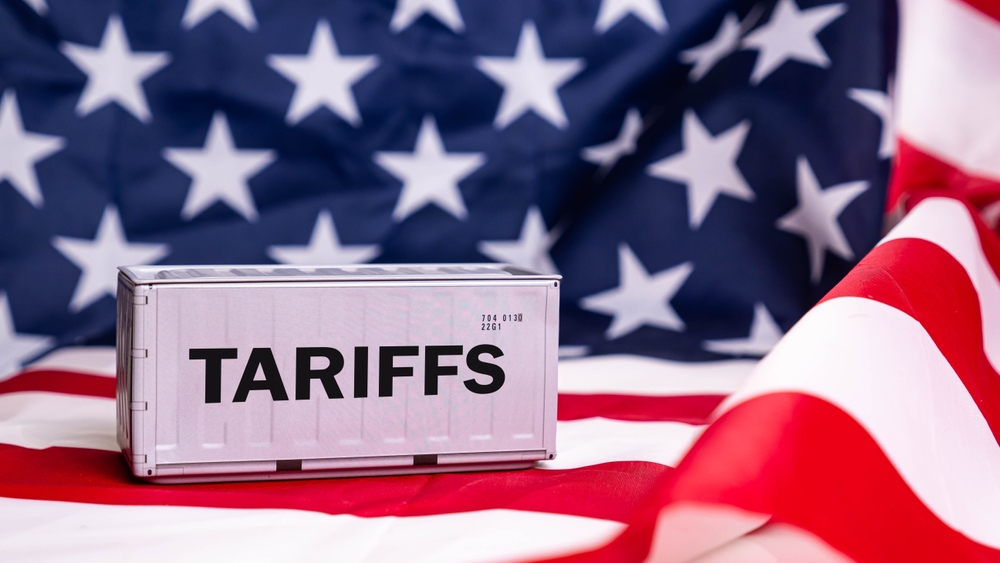Broader context
U.S. President Donald Trump had long signaled his intention to impose tariffs on China, Canada, and Mexico since his election in November. In early February, he took the first steps in enacting that plan, imposing a 10% levy on Chinese imports alongside a 25% tariff on Canadian and Mexican goods. While last-minute negotiations led to a temporary 30-day pause on tariffs for Canada and Mexico, the U.S. levy on Chinese goods took effect immediately.
In direct response, China swiftly announced countermeasures, imposing its own tariffs and export controls to mitigate the economic impact and challenge U.S. dominance in key industries. The following sections explore China’s secondary actions to overcome negative impacts smoother.
The reaction to both of these steps were warmly welcomed by the market, specifically the Hang Seng index. On the chart below, the orange line is a period when China’s retaliatory tariffs went into effect. Additionally, the blue line signals one-day jump after announcing most recent domestic measures that we will write about below.

Source: Yahoo Finance
Tariff Retaliation and Export Controls
China’s immediate response included imposing tariffs of 15% on imports of U.S. liquid natural gas (LNG) and coal, and 10% on crude oil, agricultural machinery, and some automobile products. These measures directly targeted major American export industries and will significantly impact U.S. energy and manufacturing sectors.
Additionally, China introduced new export controls on rare earth minerals and metals critical to the U.S. technology and green energy sectors. This included tungsten, tellurium, bismuth, indium, and molybdenum, which are essential for electronics, military applications, and clean energy technologies. By restricting access to these materials, China aims to leverage its dominant role in global supply chains to exert economic pressure on the United States.
Further, China’s Ministry of Commerce and its General Administration of Customs announced measures against specific U.S. companies. The Chinese antimonopoly regulator launched investigations into Alphabet’s Google or companies like PVH Corp (owner of Calvin Klein) and biotechnology firm Illumina were placed under scrutiny, indicating a broader strategy to challenge American corporate interests in China.
Expansion of Tech Investment and Monetary Easing
China has taken long-term strategic steps to bolster its economy and mitigate the impact of U.S. policies. One major initiative is the expansion of the National Venture Capital Guidance Fund, which increased from 500 billion yuan to 1 trillion yuan ($138.01 billion). This fund focuses on investments in critical technologies such as semiconductors, artificial intelligence, quantum computing, and renewable energy. By strengthening its domestic technology sector, China aims to reduce dependency on foreign innovation and counter U.S. restrictions on Chinese firms.
China has also signaled readiness for further monetary policy easing if necessary. Finance Minister Lan Foan and Central Bank Governor Pan Gongsheng confirmed that the government remains committed to maintaining a 5% economic growth rate. The People’s Bank of China (PBOC) has pledged to cut interest rates and inject liquidity when appropriate, balancing economic stimulus with the need to maintain yuan stability. This approach contrasts with U.S. economic policies, as China's proactive fiscal measures are designed to counteract the impact of tariffs while sustaining long-term growth.
Implications and Future Outlook
China’s response to the U.S. tariffs demonstrates a strategic mix of immediate economic retaliation and long-term structural adjustments. While tariffs on U.S. energy products impact only a fraction of China’s total imports, restrictions on rare earth minerals pose a significant challenge to American industries reliant on these critical materials. By expanding technological investments and maintaining a flexible monetary policy, China is positioning itself to mitigate short-term disruptions and strengthen its global economic influence.
Looking ahead, the trajectory of U.S.-China trade relations will depend on diplomatic negotiations and whether the president Trump can de-escalate tensions and return to trade without tariffs. If no resolution is reached, China may further expand its retaliatory measures, including additional trade restrictions and financial policies that favor domestic industries. Meanwhile, the U.S. may seek alternative supply chains for critical materials, but China’s dominance in these sectors remains a formidable advantage. As global markets react to these developments, the outcome of this trade dispute will have lasting implications for international commerce and economic power dynamics.


